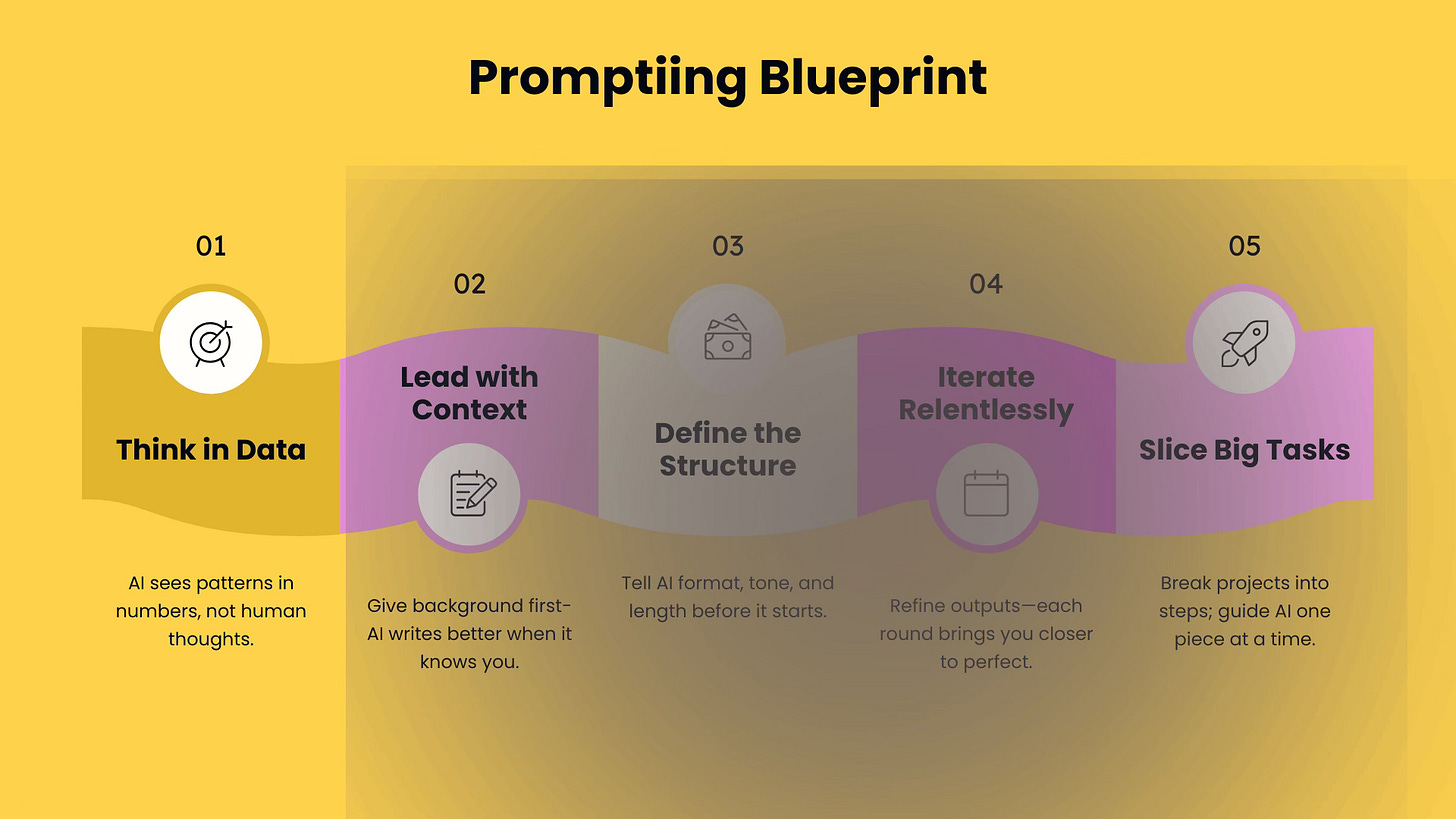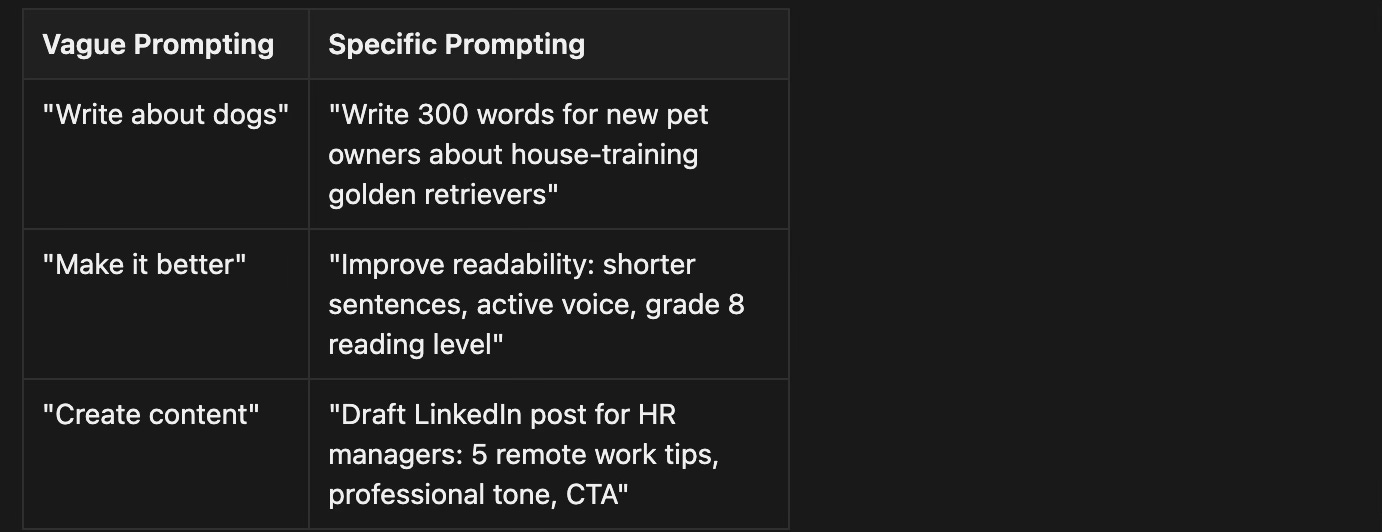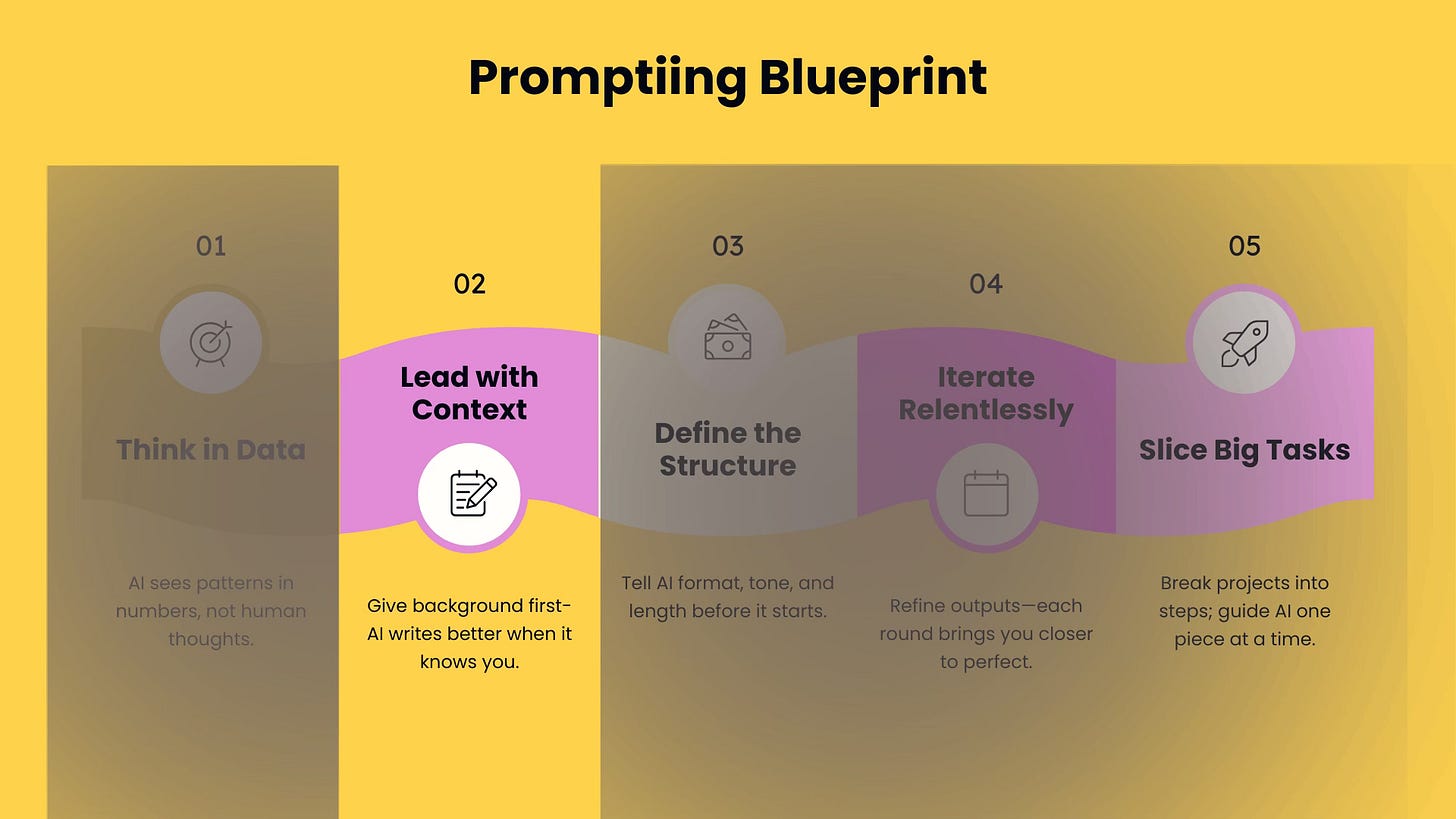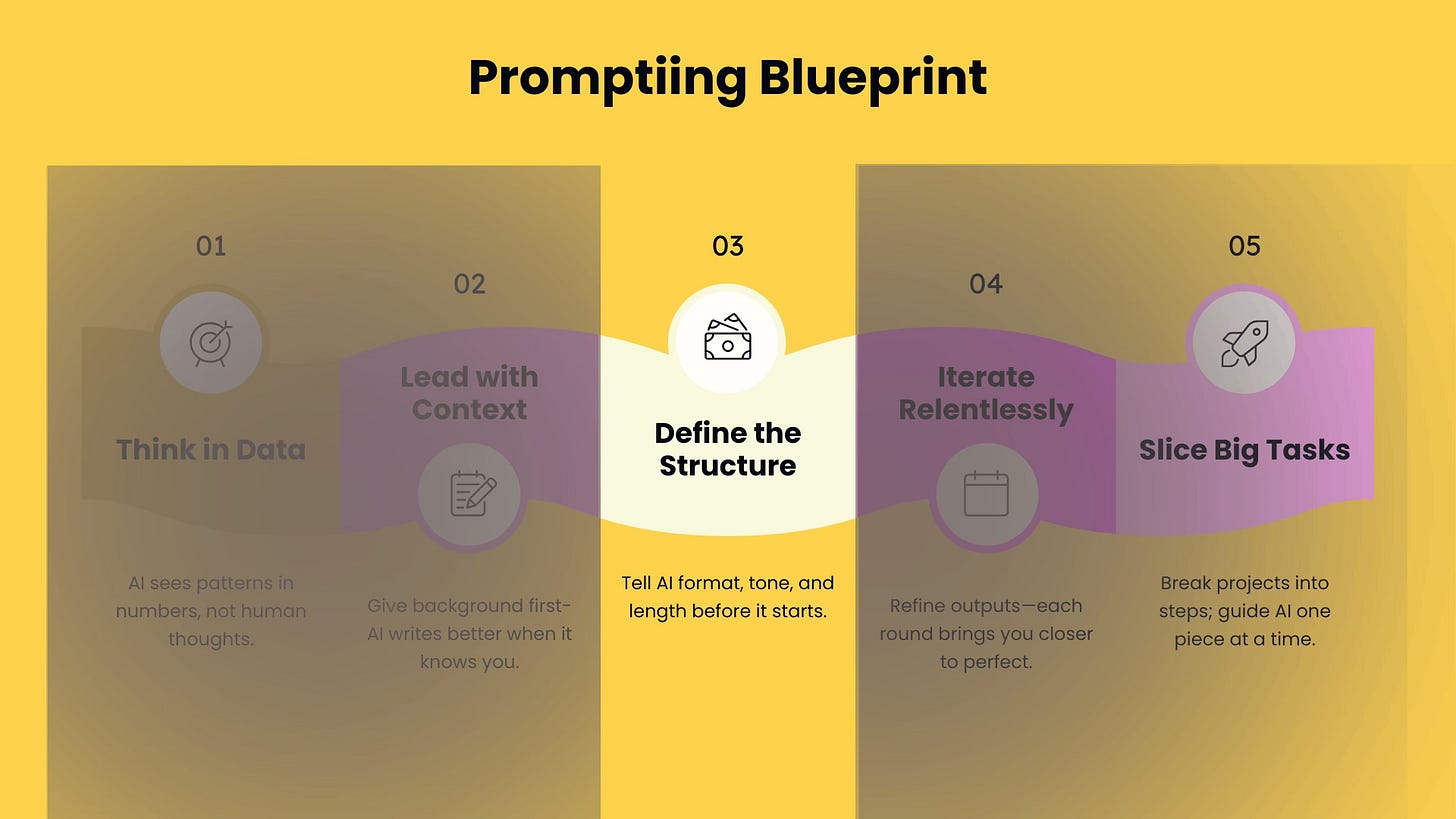I Took Google’s Prompting Course So You Don’t Have To
Here are the only 6 takeaways that matter.
Most people are using AI completely backwards.
After studying Google's prompting course and testing hundreds of prompts, I discovered why most creators get mediocre AI results. They're missing these 6 critical techniques that completely transform AI output quality.
1. AI Doesn't Think Like You (And That's The Point)
Why This Matters
While you visualize walking your dog as a mental movie, AI sees numbers. Dog = 47592. Human = 83641. Park = 29384. It finds patterns between these numbers to understand your request.
This numerical processing is actually AI's superpower. It can analyze millions of relationships instantly, but only if you speak its language. The more specific data points you give it, the more precise patterns it can find and the better your results become.
The Common Mistake
Most people write prompts like they're texting a friend: "Write something good about productivity." This forces AI to guess your intent, audience, and desired outcome—leading to generic, unhelpful responses.
The Right Way
Speak AI's numerical language by being hyper-specific with context, audience, and constraints. Think of each detail as a data point that helps AI narrow down exactly what you want.
How To Do It
Instead of: "Write about productivity"
Try: "Write a 400-word article for overwhelmed 40+ executives about time-blocking benefits. Include 3 actionable steps. Avoid buzzwords."
To help me automate this process, I created a "Prompt Generator" which takes all these into account and creates a prompt for you, specifically designed for creators-
Here is the link, in case you are interested - Access "Prompt Generator" Example
Bad: "Make a social post"
Good: "Create an Instagram caption for B2B SaaS founders about Monday motivation. Include 2 hashtags, 1 question for engagement, under 150 characters."
2. Context Is Your Secret Weapon
Why This Matters
AI has no memory of your business, audience, or goals. Every prompt starts from zero unless you provide context. It's like hiring a brilliant writer who knows nothing about your company, they need background information to create relevant content.
Without context, AI defaults to generic, one-size-fits-all responses. But when you provide rich background, it can tailor everything to your specific situation, creating content that feels like it was written by someone who truly understands your business and audience.
The Common Mistake
Jumping straight into requests without establishing who you are, what you do, or who you're targeting. This leaves AI guessing about your industry, audience pain points, and brand voice.
The Right Way
Front-load every prompt with relevant background information about your situation and audience. Think of it as setting the stage before asking for the performance.
How To Do It
Start prompts with: "I'm a [role] helping [audience] with [problem]. My brand voice is [tone]. I need..."
Example
"I'm a productivity coach for burnt-out entrepreneurs. My audience are 6-figure business owners working 60+ hours weekly. My tone is empathetic but direct. Write an email subject line about delegation that gets opened."
3. Tell AI How To Structure Success
Why This Matters
AI needs explicit instructions about format, style, and presentation to deliver exactly what you envision. It's incredibly capable but can't read your mind about whether you want bullet points or paragraphs, formal or casual tone.
Think of AI as having access to every writing style ever created, but it needs you to specify which one you want. The clearer your structural instructions, the more precisely it can match your vision and save you editing time.
The Common Mistake
Hoping AI will magically know you want bullet points, not paragraphs, or a casual tone, not formal. This leads to content that's well-written but completely wrong for your needs.
The Right Way
Specify format, length, style, and what to avoid before asking for content. Be as detailed about the structure as you are about the topic itself.
How To Do It
"Format: 5 bullet points. Length: under 200 words. Tone: conversational. Avoid: jargon, complex sentences."
Example
"Act like a direct-response copywriter. Write 3 Instagram ad variations for online courses. Format: headline + 2 sentences + CTA. Avoid: 'game-changer' and 'revolutionary.'"
I created a Prompt framework library, which consists of a Prompting framework for research, writing, and fact-checking.
This is designed for newsletter creators only.
Here is the link to the "Writing Prompt Blueprint" in case you are interested.4. Embrace The Iteration Game
Why This Matters
The first response is rarely the best response. Great AI output comes from refinement, not one-shot perfection. AI excels at taking feedback and improving, but most people accept the first attempt and miss out on dramatically better results.
Each iteration teaches AI more about your preferences and desired outcome. This collaborative approach often produces content that's significantly better than the initial response, tailored exactly to your needs through progressive refinement.
The Common Mistake
Using AI's first attempt and wondering why results feel generic or off-brand. This is like hiring a writer and never giving feedback, you'll never get their best work.
The Right Way
Treat AI as a collaborative partner. Ask for improvements, variations, and its own suggestions. Build on each response to get closer to your ideal outcome.
How To Do It
After initial output, try: "Make this more specific to [audience]" or "Ask me 3 questions to improve this response."
Example
First prompt: "Write an email about our new feature"
Follow-up: "Make it more urgent, add social proof, and ask me what customer pain points to emphasize"
5. Break Big Tasks Into Bite-Sized Prompts
Why This Matters
Complex requests overwhelm AI. Simple, connected prompts create better results than trying to do everything at once. Just like humans work better with clear, manageable tasks, AI produces higher quality when focused on one specific element at a time.
This chain-of-thought approach also allows you to guide the direction at each step, ensuring the final output aligns perfectly with your vision. Each step builds on the previous one, creating a logical flow that produces cohesive, well-thought-out results.
The Common Mistake
Asking AI to "create a complete marketing strategy" in one prompt. This produces surface-level, generic advice that lacks the depth and specificity you need.
The Right Way
Chain of thought: Break complex projects into logical steps, using each output to inform the next prompt. Think of it as building a house-foundation first, then walls, then roof.
How To Do It
Step 1: "List 5 content pillars for a productivity newsletter"
Step 2: "Expand pillar #3 into 3 specific article ideas"
Step 3: "Create an outline for the first article idea"
Example
Instead of: "Plan my entire content calendar"
Try: "What are 3 content themes my audience struggles with?" → "Give me 4 post ideas for theme #1" → "Write hooks for idea #2"
6. Go Beyond Text (Your Visual Advantage)
Why This Matters
Most creators only use text prompts. Adding images unlocks AI's full understanding and creates more accurate, detailed responses. AI can analyze visual elements like color, composition, style, and mood that would take paragraphs to describe in text.
Visual context eliminates guesswork and assumptions. Instead of AI imagining what your product looks like, it can see exactly what you're working with and provide recommendations based on actual visual elements, not generic advice.
The Common Mistake
Trying to describe visuals with words when you could just show the image. This leads to AI making assumptions about style, color, and composition that might be completely wrong.
The Right Way
Combine images with text prompts for context-rich requests that produce superior results. Show AI exactly what you're working with, then ask for specific improvements or content based on what it can see.
How To Do It
Upload screenshots, photos, or designs alongside your text prompts for better understanding. The more visual context you provide, the more precise and relevant the output becomes.
Link of Prompt Generator:- [Access Here]
Link to Newsletter Writer Blueprint:- [Access Here]










Awesome breakdown!
Nice post 👍